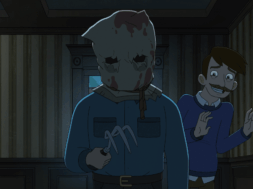Suspiria, the 1977 Italian horror movie directed by Dario Argento, has long been acclaimed as a “classic” by many horror fans. However, as much as I love Italian horror movies and as much as I admire Argento’s work, I have to say that Suspiria just did not do it for me. In fact, I think it is rather an overrated horror movie, and an extremely dull one at that.
I have watched Suspiria on both DVD and Blu Ray, and whilst the latter format renders the movie absolutely stunning in terms of picture quality and vibrant colours, the failings and cracks in the storyline still stick out like a sore thumb. This is a great pity, as if the movie’s plot had been as wonderful and awesome as its colourful presentation, then I would have certainly added my own laudatory comments to the ones of those who love the film.
Suspiria opens with the main protagonist, American ballet student Suzy Bannion (Jessica Harper), travelling through a stormy night (now THERE’S a horror cliché if ever there was) to join an exclusive ballet school. During her taxi journey from the airport, she starts to experience real feelings of mounting dread and unease, and we are led to believe that this is, apparently, going to be one hell of an enjoyable movie. This impression is compounded by the events of the next twenty minutes, which culminate in a brutal murder.
When Suzy returns to the school the next morning, she discovers that the student seen being chased through the woods the previous evening fell victim to a brutal killer. The school principal, Madame Blanc (Jean Bennett), attempts to allay Suzy’s anxiety. However, the rather curt and authoritative manner displayed by her assistant, Miss Tanner (Alida Valli), only adds to Suzy’s nervousness. Apparently, this isn’t the first time that a student has gone missing from this school.
As time goes on, the ominous feeling that not everything is quite as it seems at this establishment just grows and grows. Despite Suzy’s efforts to fit in with her fellow students, they are not exactly warm and welcoming. She does, however, eventually befriend a girl called Sara (Stefania Cassini), who then disappears after being stalked by a sinister, malevolent force. Realising that her own safety – and even her life – could be at risk too, Suzy decides that she must get to the bottom of whatever dark, untold secrets that this establishment may be harbouring.
One of the main faults of Suspiria, in my opinion, was the superfluous use of bright colour and showy camera angles at the expense of a good, solid storyline. Also, there were far too many moments in the movie that show Suzy just walking down seemingly endless corridors. There is nothing more I hate in a horror movie than boring, drawn-out stretches in which the character neither says anything nor interacts with anybody. It just leaves you wondering how long is this interminable scene going to go on for before something happens.
Another aspect of Suspiria that I hated was the general ambiguity of the story as a whole. I mean, just what was the seemingly malevolent force that was besetting the school? Was the school just a front for a collectively planned murder spree? And were all the senior staff really part of a witches’ coven? Well, we do eventually learn at the end that the latter did seem to be true, as Suzy stumbles on them all gathered in a room, with the principal uttering typical witchlike threats in Suzy’s direction. But even though it did seem to explain the nature of the threat to an extent, that ending was just too flat and anti-climatic for my liking. The movie started off so promising, but ended so badly.
Given all the critical acclaim that has been heaped on Suspiria over the years, I tried to like the movie, I really did. Unfortunately, I have to say that its lifeless plot, coupled with its mostly unspeaking characters, left a lot to be desired. Unlike most of Argento’s other films, Suspiria is certainly not a movie I could go back and watch again and again.
Source by Alan Toner









